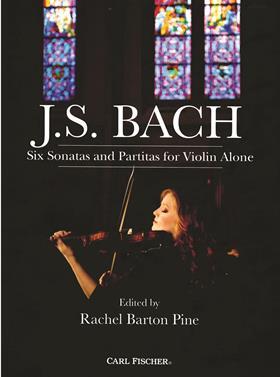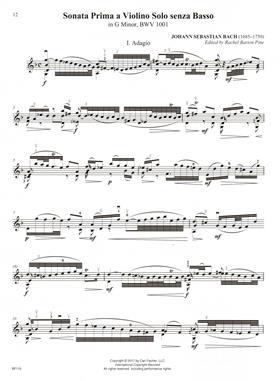
Bach: Six Sonatas and Partitas for Violin Alone
Ed. Rachel Barton Pine
80PP ISBN 9781491150993
CARL FISCHER $19.99
Rachel Barton Pine’s edition is a labour of love. She has lived with this music intimately for a long time, performing the cycle widely and making a fine recording of it in 2015. This is the distillation of her extensive experience and in-depth thinking.
Initial impressions may well be influenced by the prominence of her photograph on the front cover, the length of her biography before the music begins, and the extensiveness of her markings; yet one is rewarded by looking beyond any reservations, as her work is meticulous, generous and stimulating.
Presented with great care, this edition stands out for its combination of scrupulous adherence to the original manuscript and profuse additional markings (fingerings and dynamics, in particular). The densely marked copy might seem inhibitory or restrictive, as it is not necessarily suited to everyone’s needs or vision of the music. However, a major benefit is that the book is complemented by online study aids downloadable from the publisher’s website.
One is a copy of the original manuscript, clearly laid out, formatted and unmarked save for useful bar numbers; another intersperses the original manuscript and a clean copy to enable easy comparison. The dance movements of the B minor Partita and their doubles are laid out as duets. One study aid highlights the perfect 5ths in the E major Loure (Third Partita) to illustrate how to prepare the left hand to deal with this challenging technical aspect of these unaccompanied works. There are other similar nuggets.

Some of the fingerings in the main edition do not seem to cater to a wide range of violinists. There is, of course, an underlying logic to them, as they largely stick to first position and embrace the open strings, according to period practice.
At times this search for purity, natural resonance and a certain austerity of sound (in evidence in Pine’s recording) is convincing, yet there are distinctly awkward corners: for instance, in the first piece of the set, the Adagio of Sonata no.1 in G minor, the last beat of bar 16, where there are repeated string-crossings from E to A. Perhaps these were conceived with the Baroque bow in mind but in conjunction with modern violin set-up they cause issues of tone colour that could be detrimental to the musical line.
As for the profuse dynamic markings there is much that is thought-provoking in the way that these are employed to phrase, to shape harmonic progressions and to underline pulse. Pine also frequently inserts accents as rhythmic stresses, notably introducing hemiolas at cadences – but to take these accents too literally would be musically questionable. Indeed, Pine herself does not do so in her recordings.
The edition does not touch upon matters of articulation and types of bow stroke. That there remains so much left to interpretation speaks to the richness of interpretative possibilities offered by the music.
The excellent foreword gives a vivid overview of the cycle, incorporating historical background, descriptions of the works both individually and in terms of the overall architecture, and performance suggestions. Pine explains her approach to key aspects and clarifies certain decisions – regarding rhythm, how to manage the polyphony, ornamentation and other stylistic aspects, fingerings and bowings and dynamics.
The strong case she makes for the use of the Baroque bow is persuasive because it is practical and undogmatic.
The book is easy to use but perhaps slightly flimsy given how much use it is likely to get. With its distinctive approach, this edition may not be a first choice for everyone, but its many qualities certainly make it a worthwhile and important one to have, and a very apt one for our time.
NATHANIEL VALLOIS
This review was first published in the January 2019 issue of The Strad





























No comments yet